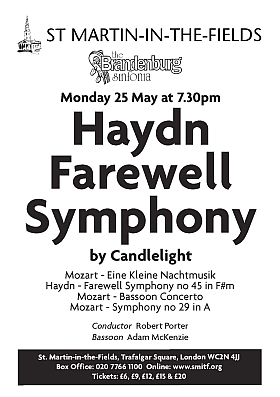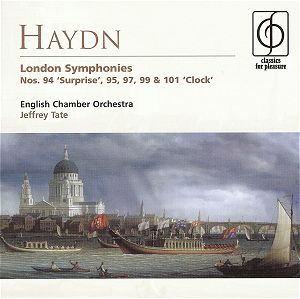Joseph Haydn
[ˈjoːzɛf ˈhaɪdən] (1732 - 1809, Austrian)
- the "Father of the Symphony", although he did not invent the form
- his 108 works in the genre pioneered its evolution, from a 3-movement Baroque overture for fewer than 20 players, to the 4-movement form for as many as 60
When the tempo is changed from presto (very fast) to adagio (slow) in the middle of the movement (by 4:18 ), the performers start to leave the stage!
It was by Haydn's design. Their boss made them perform in a summer palace for long, but disallowed them to bring their families along. Aware of his team's grief, Haydn wrote the score so that the performers, one after the other, put out their candles and fare-welled the stage. The boss finally got the message and in the next morning announced leaving the summer palace for home. Thus nicknamed “Farewell” Symphony.
It was long thought to have been composed for a visit by the Holy Roman Empress, Maria Theresa of Austria
- The Holy Roman Empress, Maria Theresia of Austria, was superbly beautiful, but she destroyed all her portraits after contracted small pox. One of her beautiful daughters, Marie Antoinette, was married to the dull Prince Louis of France. They were later guillotined during the French Revolution. Their son, nominally Louis XVII, was imprisoned until his death from negligence and illness at the age of 10; he was never officially king.
Haydn did not appreciate those who fell asleep during his performance. So he humorously designed this piece to wake up the sleepers. Thus nicknamed "Surprise"
'The nickname "Military" Symphony derives from the second and the fourth movements, which feature prominent fanfares written for C-trumpets and percussion effects.'
It is popularly known as "The Clock" because of the "ticking" rhythm throughout the second movement.
Symphony no. 101
* Mvt 2: AndanteIt is popularly known as "The Clock" because of the "ticking" rhythm throughout the second movement.
- Haydn's last symphony
I. Adagio – Allegro
(solemn intro, then lyrical allegro)
II. Andante
(full orchestra, then gentility)
III. Menuetto and Trio: Allegro
(frequent syncopations, surprises; orchestral timber in Trio)
IV. Finale: Spiritoso
(Croatian folk tune & London street seller's cry, joyful end)
(12 of Haydn's later symphonies are known collectively as the “London” Symphonies.)
At age of 77, Haydn died shortly after Napoleon’s French army attacked on Vienna
Source: Wikipedia
 |
| Haydn on harpsichord at left bottom corner |





No comments:
Post a Comment